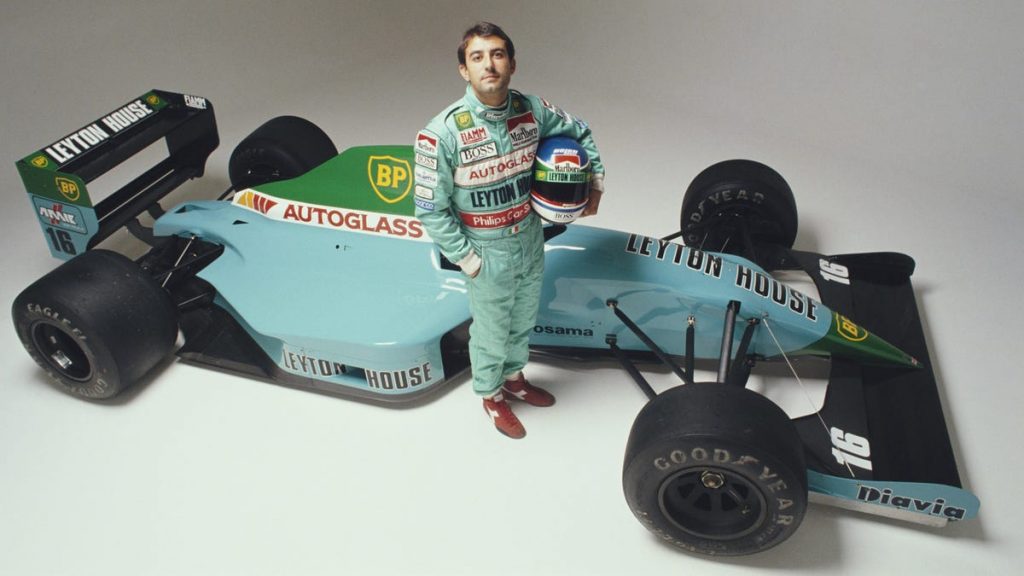Leyton House's Gorgeous Formula 1 Cars Came With Financial Scandal

Portrait of Ivan Capelli, driver of the No. 16 Leyton House Formula One Racing Team ahead of the 1990 season.Photo: Pascal Rondeau (Getty Images)
When Leyton House, a Japanese real estate company and lifestyle brand, bought its way into Formula 1, it did so by taking over the longstanding March team and rebranding it with Leyton House’s gorgeous turquoise paint scheme. Within five years, though, Leyton House founder Akira Akagi was arrested due to financial scandal, and the bloodline of the storied March team was no more.
(Editor’s note: This week marks the release of Racing with Rich Energy: How a Rogue Sponsor Took Formula One for a Ride by Elizabeth Blackstock and Alanis King. To celebrate a book that began as a blog on Jalopnik, co-author Blackstock is covering the history of some of F1’s other questionable sponsors. These sponsors are touched on in the book, but not in depth. Racing with Rich Energy is available via McFarland, Amazon, Kindle, and Eurospan for international buyers.)
Akira Akagi, team owner of Leyton House Formula One Racing Team, at the 1990 British Grand Prix.Photo: Pascal Rondeau (Getty Images)
Motorsport history buffs know just how critical March Engineering was to the trajectory of Formula 1. In 1969, founders Max Mosley, Alan Rees, Graham Coaker, and Robin Herd joined forces to begin building Formula 3 chassis before quickly entering F1. In an era where F1 teams generally manufactured their own racing machines in-house, March instead offered chassis for purchase, enabling plenty of teams to buy their way into the sport. While the chassis weren’t necessarily the pinnacle of technology, they remained competitive enough to remain a viable business endeavor, largely because the chassis were cheap enough to be affordable to small teams.
That being said, a lack of budget and the differing interests of the founders slowly saw the powerhouse of the 1970s relegated to Formula 2 and IndyCar before March began to fall apart. A lack of both funds and passion kept the team out of regular F1 competition until 1987, when it was lured back into the sport by Ivan Capelli and his sponsor, Leyton House.
G/O Media may get a commission
20% Off
JX Fitness Dumbbell Rack
Gains but tidy
Has a three-tier design to help store more weights more conveniently, can safely support up to 1000lbs of weight, which should be enough for most people, has a triangle base for stability, and also features anti-scratch feet which is great if you’ve built your own studio or workout in your garage.
Ivan Capelli of Italy drives the No. 16 Leyton House Racing March during the 1989 Japanese Grand Prix.Photo: Pascal Rondeau (Getty Images)
Leyton House chairman Akira Akagi was looking for new avenues of brand marketing when he decided to develop his own racing team in 1986, and he started off with Japanese championships closer to home. Akagi had pinned his racing hopes on Akira Hagiwara, an immensely promising driver, only for Hagiwara to be killed in an early test session for a touring car.
That sent Akagi farther afield, to international events, as a way to scope out potential talent, and it was at a Formula 3000 event at Imola that he met Cesare Gariboldi, who served as manager for Ivan Capelli. Negotiations ensued, and with some Leyton House backing, Capelli competed in a partial Japanese Formula 2 season before Akagi offered him extra finances to take on European racing.
From Motorsport Magazine:
“The man who physically introduced me to Mr Akagi is now the big boss of Bridgestone, Mr (Hiroshi) Yasukawa, who was following F3000 in Europe at the time,” remembers Capelli. Struggling for funds to complete the season in his Genoa Racing March, Capelli was keen to race for Leyton House in Japan and earn some much-needed prize money: “I said to Mr Akagi, ‘OK, you will give me 30 per cent of the prize money.’ After I finished second for him at Fuji I was in his office and asked to check the money, and when I did I realised it was 50 per cent. So I was giving back the money to him and he said, ‘No, no, you can keep it.’ From that good feeling between us we started to talk about sponsorship of my F3000, and then he gave me more money to continue in Europe.”
Capelli and his manager knew that Akagi had some money, and when he offered the driver $200,000 (or about $540,000 adjusted for inflation) to compete in another Japanese championship, the duo pitched something even bigger: Formula 1.
“We were still talking as we went to the airport,” Capelli told Motorsport Magazine, referring to the end of his 1986 European racing season, “and finally at the airport we shook hands and Mr Akagi said to me, ‘You are in F1 and I will give you four million dollars!”
The No. 11 Leyton House Porsche 962C driven by George Fouche, Franz Konrad and Wayne Taylor during the 1987 24 Hours of Le Mans on 13th June 1987.
Photo: Simon Bruty (Getty Images)
Gariboldi had spent the 1986 season forming bonds with Robin Herd, and the two started putting together a revival for the March team, which would be sponsored by Leyton House. By the first race of the 1987 season, though, things weren’t exactly looking good: the entire team was composed of 17 people, the Grand Prix car boasted a World Sports Car Championship-spec engine, and the car’s chassis was a modified F3000 chassis. The fact that Capelli scored a point in the 1987 Monaco Grand Prix was something of a shock.
The following year, though, was far more successful. Adrian Newey had joined the team in August of 1987, and the car he designed for 1988 — mated with a Judd engine — brought drivers Capelli and Mauricio Gugelmin 22 points. Things were looking good.
Then in 1989, problems began to arise. In May, March sold its F1 team and the rights to produce F3000 cars to Akira Akagi of Leyton House. Cesare Gariboldi died, and many March personnel stepped away. And the car that year was an absolute disaster thanks to the the gearbox, which can be illustrated by the fact that Capelli only finished two of that year’s 16 races.
For 1990, then, Leyton House was full owner of the team, and things got off to a poor start. The wind tunnel used by the team had issues, meaning that Capelli and Gugelmin both failed to qualify for or finish the first six races of the year. Newey was fired after making the changes that ultimately turned the car’s fortune around — if only briefly. Capelli finished second in France, and Gugelmin took one point for finishing sixth in Belgium.
The continued struggles of Leyton House Racing in the latter half of the season had a lot to do with the fact that it was running into financial issues. Akagi may have realized that running an F1 team was more expensive than intended, because he brought in an accountant to help him manage an ever-decreasing budget.
From Motorsport Magazine:
“Akagi was starting to struggle,” says Newey. “He borrowed heavily against the banks but had to be seen to be still in F1, because if he pulled out the banks would have wondered why. He was playing a poker game on the minimum cost possible, so he was reducing the budget constantly and brought in an accountant (Simon Keeble). When Ian had his meningitis Keeble suddenly assumed power and that really was the beginning of the end — having an accountant running an F1 team was a disaster.”
Things finally came to a head as a disappointing 1991 season came to a close. In September, Akagi was implicated in a financial scandal involving the Fuji Bank in Japan and was soon arrested, leaving the team scrambling to continue. During the last two races of the year, Capelli even took a step back to allow Karl Wendlinger to compete behind the wheel of his car, since the German driver brought significant funding from Mercedes.
Things fell apart soon after. With the money man Akagi out of the picture, Leyton House Racing was sold to a consortium that included Akagi’s British representative Ken Marrable, lawyer John Byfield, and Dutch motorsport businessman Henry Vollenberg. The consortium renamed the team March, and they signed Wendlinger and wealthy Paul Belmondo. When Wendlinger ran out of money, he was replaced by Jan Lammers. Belmondo, too, was replaced, with Emanuele Naspetti taking his seat.
The consortium knew it was in trouble and attempted to sell March to someone else in 1993, but a potential deal with a Swiss investment group stalled. So, four days before the season’s opening race, March withdrew from F1, putting an end to the team’s storied history in the sport.
Akagi, for his own part, served a decade in prison for fraud tied to financing his racing endeavors. Upon his release, he started an investment company, which he ran until passing away at age 73 in 2018.




